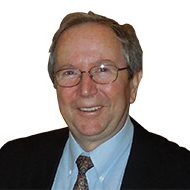
 Dr. Raymond Sterling is Professor Emeritus at Louisiana Tech University. From 1995 to 2009 he was the Contractors’ Educational Trust Fund Professor of Civil Engineering and Director of the Trenchless Technology Center at Louisiana Tech University. Previously, from 1977 to 1995, he was the founding director of the Underground Space Center at the University of Minnesota. Dr. Sterling received his B.Eng degree (1st Class Hons) in civil and structural engineering from the University of Sheffield in 1970. He received his M.S. and Ph.D. degrees from the University of Minnesota in 1975 and 1977.
Dr. Raymond Sterling is Professor Emeritus at Louisiana Tech University. From 1995 to 2009 he was the Contractors’ Educational Trust Fund Professor of Civil Engineering and Director of the Trenchless Technology Center at Louisiana Tech University. Previously, from 1977 to 1995, he was the founding director of the Underground Space Center at the University of Minnesota. Dr. Sterling received his B.Eng degree (1st Class Hons) in civil and structural engineering from the University of Sheffield in 1970. He received his M.S. and Ph.D. degrees from the University of Minnesota in 1975 and 1977.
Dr. Sterling’s career has involved studies across a wide range of technical disciplines and their broader social applications. He has undertaken international and national leadership positions in a variety of professional and technical organizations. He is a Past Chairman of the International Society for Trenchless Technology (ISTT) and the North American Society for Trenchless Technology. He is a Past President of the Associated research Centers for Urban Underground Space (ACUUS), past Vice Chairman of the Committee on Underground Space of the International Tunnelling and Underground Space Association (ITA) and Past Chairman of the U.S. National Committee on Tunneling Technology of the U.S. National Research Council. Dr. Sterling has enjoyed a special connection to China with regard to both the development of underground space use and the advancement of trenchless technologies. He is an Advisory Professor at Tongji University and an Advisory or Honorary Professor at several other Chinese Universities and has visited China over 30 times since his first visit in 1981 as the head of a U.S. Delegation to foster collaboration in the fields of underground space use and underground engineering.
From 1996 to 2015, Dr. Sterling served as a Senior Editor of the international journal Tunnelling and Underground Space Technology. In 2003, he received the Stephen D. Bechtel Pipeline Engineering Award from the American Society of Civil Engineers (ASCE). In 2009, he received the Gold Medal from the ISTT for outstanding contributions to trenchless technology. He is a Fellow of ASCE, ITA and ACUUS and, until his retirement from the university in 2009, he was also a Fellow of the UK Institution of Civil Engineers, the UK Institution of Structural Engineers and the UK Royal Society for Arts, Manufacture and Commerce. He has authored approximately 200 books, technical papers and reports on a wide range of topics related to underground space use, underground construction, geomechanics and trenchless technology. He served for several years on International Advisory Committees for the Singapore Ministry of National Development and has been a consultant for several underground space planning initiatives in Singapore and Hong Kong. In 2025, the second edition of his 1993 co-authored book with John Carmody on Underground Space Design will be published by Wiley.
Dr. Sterling’s paper, entitled “Minimizing Problems and Maximizing Benefits from Underground Space Use,” takes a broad look at how we are using and designing underground spaces with the intent of focusing attention on planning, design and use issues that will render underground space use more sustainable, more resilient and, overall, more successful in the future. Underground space uses are increasingly important to support our living patterns, our material needs and to improve the sustainability of our way of life. Many underground facilities serve their intended function well and have proven to have long lifetimes. Some have not been so successful (for a variety of reasons) or have been retired as no longer meeting the original purpose and not being suitable for conversion to another purpose. While the difference between success and failure is often tied to the specifics of a particular project, this paper seeks to extract some of the general principles that underlie the benefits or drawbacks of different types of underground space uses and how to maximize “success”. The paper is a mixture of the general and the specific because both play a role in success. The paper draws significantly from a recent study of the “lessons learned” from 42 worldwide underground facilities with an average of over 37 years of service mixed with other observations by the author from a career of studying underground space use and underground construction technologies.
Registration
Before May 23, 2025
Lecture Date
13:30-18:00, May 24 2025